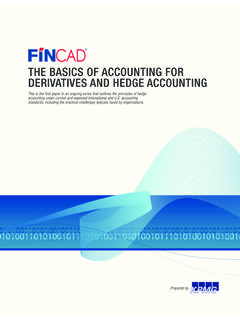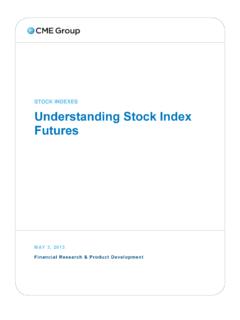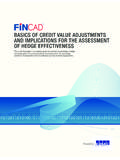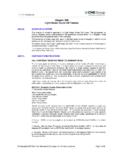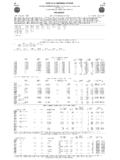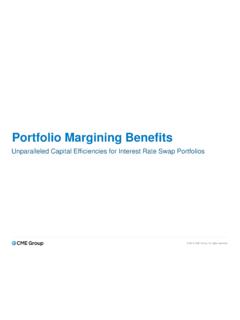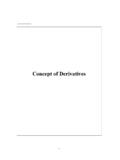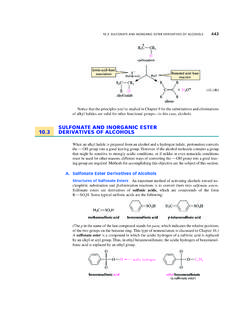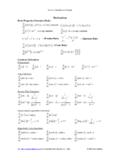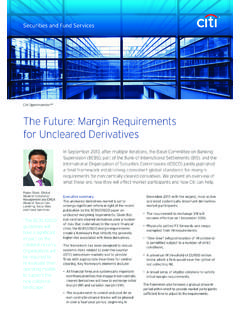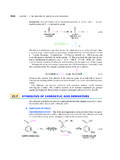Transcription of I n t r oduction to Weather Derivatives - CME Group
1 1I n t roduction to Weather Derivativesby Geoffrey Considine, , Weather Derivatives Group , Aquila EnergyIntroductionThe first transaction in the Weather Derivatives market took place in that time, the market has expanded rapidly into a flourishing over thecounter (OTC) market. Further growth in the end-user sector is somewhat limit-ed by the credit issues associated with an OTC market ( , satisfying theInternational Securities and Derivatives Association Master Swap Agreement).To increase the size of the market and to remove credit risk from the trading ofweather contracts, the Chicago Mercantile Exchange (CME) is introducingweather Derivatives to be traded electronically on the CME sGLOBEX 2system. The individual contracts are calendar-month futures (swap) contracts onheating degree days (HDD) and cooling degree days (CDD) as well as optionson document discusses some of the fundamentals of pricing andanalyzing Weather Of A New MarketThere are a number of drivers behind the growth of the Weather derivative mar-ket.
2 Primary among these is the convergence of capital markets with insurancemarkets. This process is evidenced by the growth in the number of catastrophebonds issued in recent years as well as the introduction of the catastropheoptions that are traded on the Chicago Board of Trade (CBOT). Weather deriva-tives are the logical extension of this convergence. The overall growth in the securitization of risk in the Weather and catastrophe markets shows no signs ofslowing. The Weather derivative market was jump started during the El Ni owinter of 1997-98, one of the strongest such events on record. This event wasunique in terms of the publicity that it received in the American press. Manycompanies, faced with the possibility of significant earnings declines because ofan unusually mild winter, decided to hedge their seasonal Weather risk. Weatherderivative contracts are particularly attractive to businesses that have experiencewith financial options and futures.
3 The insurance industry was facing a cyclicalperiod of low premiums in traditional underwriting businesses in this same peri-od and was in a position to make available sufficient amounts of risk capital tohedge Weather risk. The large base of written options from insurance companiesprovided the liquidity for the development of a monthly and seasonal swapmarket in first Weather transaction was executed by Aquila Energy as a Weather option embedded in a power contract. 2 For specifics on the Weather contracts, visit the Chicago Mercantile Exchange sWeb site Weather RiskAcompany has a number of alternatives in structuring a Weather deal. The firstalternative is most similar to an insurance product to buy a cooling degreeday option (CDD)in the case of summer, or a heating degree day option(HDD) for number of cooling degree days on a single day is the dif-ference of the daily average temperature from 65 degrees Fahrenheit.
4 Coolingdegree days and heating degree days are never negative. If the daily averagetemperature is less than 65 F, then the difference of the daily average tempera-ture and 65 F is the number of HDDs. Over the course of a month, one mightaccumulate both CDDs and HDDs. Weather options are written on the cumula-tive HDDs or CDDs over a specified period. The CME contracts therefore arebased on the total number of HDDs or CDDs in the the insurance-like purchase of a call or put option, a business withweather exposure may choose to buy or sell a futures contract, which is equiva-lent to a swap such that one counter party gets paid if the degree days over aspecified period are greater than the strike level, and the other party gets paid ifthe degree days over that period are less than the strike. Abusiness may alsochoose to write an option. Aheating oil retailer may feel that if the winter isvery cold they will have high revenues so they might sell an HDD call.
5 Ifthe winter is not particularly cold, the heating oil retailer keeps the premium onthe call. If the winter is very cold, the retailer can afford to finance the optionpay out with higher-than-normal revenues. Acustomer may wish to buy a strip of CDD or HDD contracts spanning theentire cooling season of April through October. Each contract has a specifiedstrike for each month. Each option is listed with a price for each range ofstrikes. In the OTC market, it is common for options to be written on a multi-month period with a single strike over the entire period. The benefit of buying astrip of monthly contracts is that the strip can be broken apart more readily thana single, longer-term contract. The simplest approach is to purchase a strip ofcall or put options over the range of months that are of interest to the intuitively expects, the further out of the money ( , away from normalconditions) the strike is set, the lower the price of the option (the premium).
6 The strike is set relative to the normal climatological values. The normal valueis a matter of debate. The market currently seems to be converging on the aver-age over the past 10-15 years. Clearly there are many cases in which the 15-year average may not be ideal. Miami, for example, has shown a substantialwarming trend over the past 30 years, such that 15-year average CDDs in sum-mer are less than one may expect. Of course, the market will have factored thetrend into the pricing of the option. ACDD call option will thus appear quiteexpensive if the option is simply priced at the 15-year average. Conversely, aCDD put option will appear to be inexpensive in this date, utilities have been the largest end-users of Weather , there are many other businesses in which Weather has a major impacton revenues. It is anticipated, for example, that positions in agricultural com-modities will be hedged with Weather contracts more extensively than powerand gas positions because of the long series of historical data available in the2agricultural markets.
7 Because growing degree days and cooling degree days arevery similar, standard Weather contracts could be used to hedge commodityprice risk. One of the CME-listed cities is Des Moines, and we present somecalculations that demonstrate how a considerable fraction of the volatility ofcorn prices in Iowa could be hedged using Weather options. The challenge insuch cross-commodity hedges is the development of appropriate Weather pric-ing models. Simple Option PricingSimple pricing models can be constructed using a probability distribution fittedto an historical data set of monthly CDDs or HDDs, and integrating the productof the probability distribution with the payoff of the option. The expected pay-off of a CDD option, or its theoretical value, is simply determined by: E = M P(CDD)Q(CDD)d(CDD)where P(CDD) is the probability distribution of CDDs, Q(CDD) is the payoff ofthe option in units of CDDs, M is the number of dollars specified in the con-tract per CDD, and d(CDD) is the differential.
8 The expected value changes as afunction of the strike, the probability distribution of CDDs, and the number ofdollars per CDD. We begin with an example for an HDD put option for Las Vegas for the periodfrom Nov. - March. With a mean value of 1,933 HDDs for this period (detrend-ed), we choose a strike of 1,833 to yield the following structure:3We have drawn this option (see figure on the preceding page) with $5,000 perHDD and a premium of $200,000 for demonstration purposes. At this level, thebuyer owns an option with an expected value (expected payoff minus premium)of about $24,000. The price of this option was derived from a simple pricingmodel that is discussed discuss a number of the key problems associ-ated with arriving at such a Weather options requires an historical temperature database and applica-tion of statistical methods for fitting distribution functions to data. Historicaldata is available from the National Oceanic and Atmospheric Administration(NOAA), and many inexpensive statistical packages can be used to examine thestatistical distributions in a dataset.
9 The Chi-square and Kolmogorov-Smirnofftests are two of the most common methods for evaluating a good fit in this typeof problem. In many cases, the probability distribution of CDDs and HDDs canbe fitted using a Gaussian (normal) distribution. The Midwestern ClimateCenter (MCC) has an online subscriber database that provides monthly-totalCDDs and HDDs for all cities and provides a useful resource for thoseparticipating in the market. Be aware, however, that the standard used to calcu-late CDDs and HDDs is different in the Weather market than what is used bythe atmospheric community such as the National Weather Service (NWS) andNOAA. The NWS rounds the average daily temperature to the nearest degreefor each day, whereas the Weather market does not round temperature and keepsone decimal place in the daily CDDs or HDDs. There are a number of complications in the pricing process. First, a simple dis-tribution should not be fitted directly to the historical data.
10 Many measurementsites in the exhibit significant long-term (multi-decade) trends and variability must be accounted for in a pricing model. TheCenter for Climate Prediction provides data on long-term trends across theUnited States at fairly coarse resolution. These trends cannot be used directly,however, because Weather Derivatives are struck based on a single NWS mea-surement site and a site at the end of an airport runway may exhibit differentlong-term trends from the region surrounding it. In short, there is a need tocarefully analyze the history of the specific station in question. The station datamay be poor, the tower may have been moved, or the instrumentation may havechanged. The Gaussian Pricing ModelAvery simple, and quite often sufficient, formula for pricing individual optionscan been derived for the case of a Gaussian distribution of CDDs or that one knows the mean (average) and standard deviation of CDDsor HDDs in a location, it is simple to approximate the price of an option.
